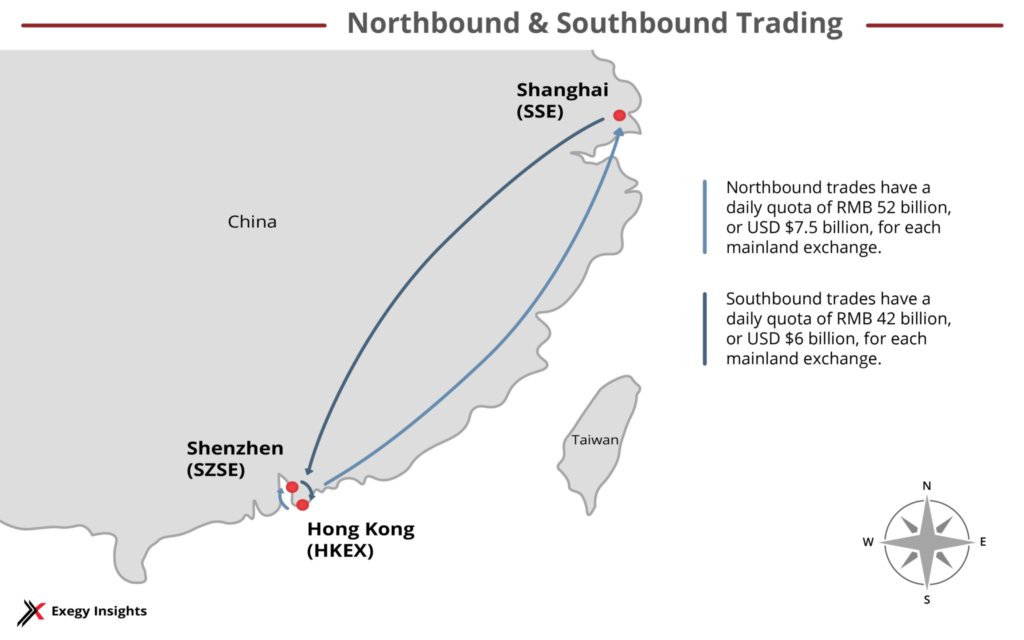Stock Connects Link Hong Kong to Chinese Equities Markets
Traders wanting to access the Chinese equities market have a gateway through the Hong Kong Exchange—the Shanghai and Shenzhen Stock Connects. The reciprocal trading arrangement allows foreign firms of all sizes to gain access to mainland liquidity and has solidified Hong Kong’s status as a leading financial market in the Asia Pacific (APAC) region. Yet, restrictions imposed by the Chinese government, as well as practical limitations, may prove challenging to firms intending to trade on the Stock Connects. This article outlines how the Stock Connect program works, and the factors a firm needs to consider before attempting to access it.
Understanding the Shanghai and Shenzhen Stock Connects
The Stock Connects were established to allow more foreign investors to trade directly in Chinese securities while giving mainland investors a way to diversify their assets outside of China.
Previously, foreigners trading on mainland exchanges had to go through a government qualification process and could only buy B- and H-class shares of Chinese companies, which were valued in Hong Kong dollars or other foreign currencies. A-class shares—which are valued in Chinese renminbi (at prices stated in Chinese yuan) and generally trade at a premium over B and H shares—were available only to mainland investors.

In 2014, the Hong Kong Exchange (HKEX) and Shanghai Stock Exchange (SSE) announced a deal that allows foreign investors to buy and sell A-class shares on the SSE through the Hong Kong exchange, while permitting mainland Chinese investors to trade on HKEX. In 2016, the arrangement expanded to include the Shenzhen Stock Exchange (SZSE).
The Chinese government has encouraged greater use of the Stock Connects by gradually loosening volume quotas and other restrictions. The daily quota (or net buy) for northbound trades—purchases on the mainland exchanges by investors trading through Hong Kong—is now RMB 52 billion (USD 7.5 billion) for each mainland exchange. The net purchase for southbound trades—those by mainland investors trading on the Hong Kong exchange—is RMB 42 billion (USD 6 billion) for each mainland exchange.
The program has accelerated the growth of mainland China’s A-share market and led to inclusion of Chinese stocks on global indices. It also has led to other investment connections being forged, including a Bond Connect in 2017, and a London-Shanghai Stock Connect and China-Japan ETF Connect in 2019.
Comparing Gateways to Mainland Chinese Markets
Previous Chinese programs allowed only two types of foreign investors:
Qualified Foreign Institutional Investors (QFIIs) must meet stringent guidelines–years of asset management experience and AUM–to trade A shares on the Shanghai and Shenzhen exchanges. They also must convert foreign currency into renminbi for trading.
Renminbi QFIIs (RQFIIs) trade in the same assets as QFIIs but can use offshore renminbi from Hong Kong. Currently, this avenue is open to institutional investors from 19 global jurisdictions, including the US.
The Stock Connects greatly expand the number of foreign traders who can buy and sell mainland stocks. But the three programs have different requirements and limitations:
Table 1. Comparing Types of Foreign Investment in Mainland China Markets
| Programs | Qualified Foreign Institutional Investor (QFII)* | Renminbi Qualified Foreign Institutional Investor (RQFII)* | Stock Connect (Northbound) |
| Investor Asset Management Experience | Bank: ≥ 10 yrs. Securities firm ≥ 5 yrs. Asset management firm ≥ 2 yrs. | Asset management license issued in home jurisdiction | No requirement |
| Investor AUM | ≥ $10 billion | No requirement | No requirement |
| Currency Used | USD | Yuan | Yuan |
| Daily Trading Quota | None | None | RMB 52 billion (USD 7.5 billion) |
| Investments Allowed | All securities on the SSE/SZSE Investment funds, including ETFs Warrants, index futures, IPOs, FX derivatives (hedging only), others | All securities on the SSE/SZSE Investment funds, including ETFs Warrants, index futures, IPOs, FX derivatives (hedging only), others | All securities on the SSE/SZSE |
| Block Trades Allowed? | Yes | Yes | No |
| Short Sales Allowed? | No | No | Yes, if covered |
| Startup Time | 2-5 months | 2-5 months | 15 business days |
Getting Started with the Stock Connects
To trade on the Stock Connects, a firm must either trade through a registered HKEX exchange participant or register to become one. Registering requires gaining a business license in Hong Kong and obtaining a stock exchange trading right. The cost of a right requires paying a USD $64,207 application fee, $39,167 in deposits, and $372/month in subscription fees.
Exchange participants can access the Hong Kong Exchange through co-location and cross connection in the HKEX data center. Alternatively, participants can connect through an application service provider (ASP) via a virtual port service (VPS).
Installing custom hardware in Hong Kong raises a number of obstacles, including the cost of shipping and rack space. Firms may be better served by a software-based ticker plant, which can be installed in local commodity hardware and is a faster path to connectivity.
Obtaining Market Data from the Shanghai and Shenzhen Stock Exchanges
As part of the Stock Connect arrangement, the SSE, SZSE and HKEX have agreed to distribute real-time Level 1 (1-depth) data from northbound and southbound trades free of charge to China Connect Exchange Participants (CCEPs). Distribution is via the HKEX Orion Market Data platform’s ChinaConnect Securities OMD-CC feed. Quotes are updated every three seconds, if there is a change.
The real-time daily quota balance for northbound trading is updated every five seconds and disseminated to participants on the Stock Connect Market feed (SCM) of HKEX Orion Market Data Platform – Securities Market (OMD-C).
Real-time Level 2 market data is handled differently on the Stock Connect; it is only released to licensed vendors. Becoming a vendor on the SSE requires a USD $60,000 license fee, plus at least $800/month.
A list of vendors is available from China Investment Information Services Limited (SSE) and from Shenzhen Securities Information Co. Ltd. (SZSE). Fees are vendor dependent.
Because the feeds are conflated and same-day turnaround of stock is prohibited, achieving low latency generally is not a factor.
Factors to Consider in Trading on the Stock Connects
When trading on the Stock Connects, firms must understand important market factors that could affect their strategies:
- Only limit orders can be placed on northbound trading. Block trades and naked short-selling are not permitted (Covered short-selling is allowed with restrictions). Foreign institutional investors may not use multiple counterparties across asset classes, impairing their ability to meet best execution obligations.
- One foreign investor can’t hold more than 10 percent of a company’s listed shares, and aggregate foreign holdings in a company can’t exceed 30 percent. The price of most securities may not move by 10 percent or more beyond the previous closing price, and northbound trading ends for the day when the net buy reaches the RMB 52 billion quota. All these factors may impair trade execution.
- Stock Connect participants trade only on days when both the Hong Kong market and the mainland exchanges are open. Between them, they close for 21 holidays in 2020 (QFIIs and RQFIIs operate on the mainland Chinese calendar, observing 16 holidays in 2020). The Stock Connect trading day is shorter than that of the Hong Kong markets, running from opening call at 9:15 a.m. to market close at 3 p.m. local time.
- A stamp duty of 0.1% is levied on northbound sales, in addition to other handling and transaction fees. China is the only major world equities market to require a T+0 settlement cycle – mandating that all trades settle on the trade date. This requires that a company have a partner or service available locally who can handle settlement details.
The trading landscape on mainland Chinese markets is shifting rapidly, with officials continually relaxing restrictions on the Stock Connect and QFII/RQFII programs to attract more foreign investors. The expectation is that it will continue to become easier to trade in this growing market.
With more than a decade of experience helping professional investors connect to global exchanges, Exegy understands the complexity of accessing market data in emerging markets. Our product suite includes a software-based ticker plant, Proxime, that is quickly deployable in overseas markets. To learn how Exegy can help you scale up your global connectivity, request a consultation.
*China’s State Administration of Foreign Exchange announced in April 2019 that it planned to merge the QFII and RQFII programs; there has been no word on the effective date for that change. This and other developments, including fees, are subject to updates by the Chinese authorities and the Hong Kong Exchange; check the exchanges’ websites for the most up-to-date information.




